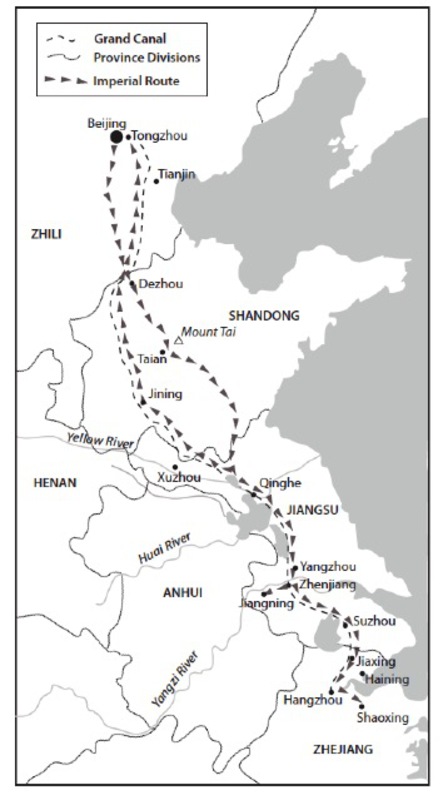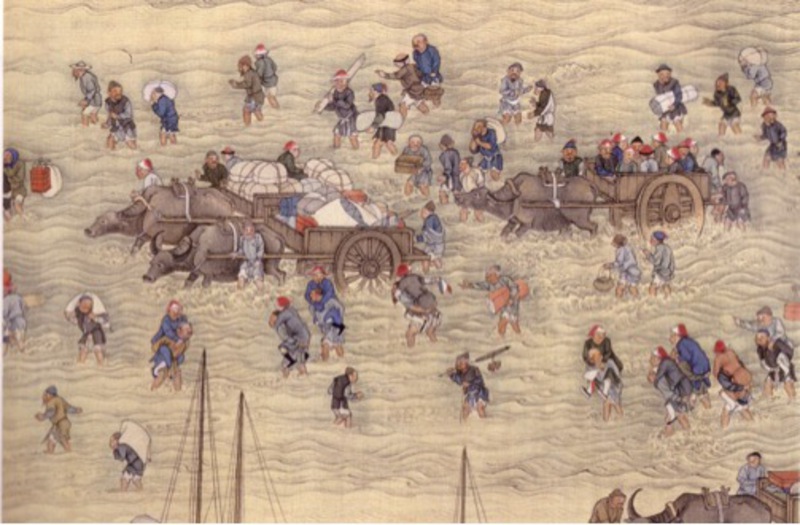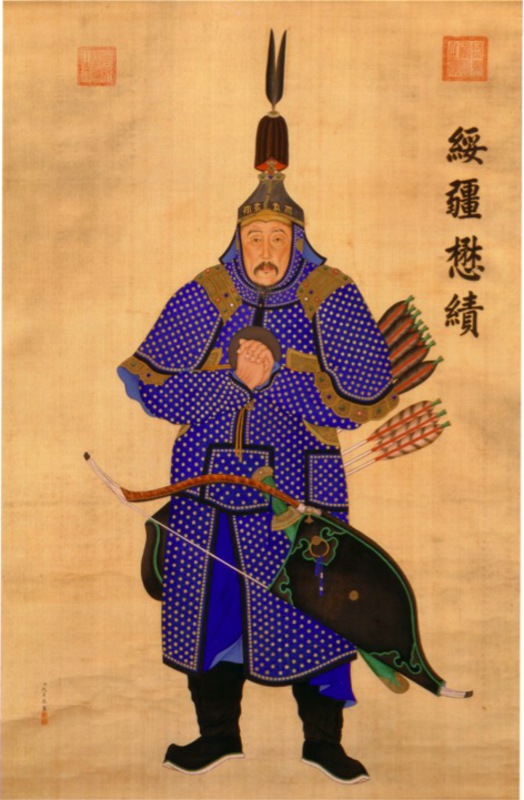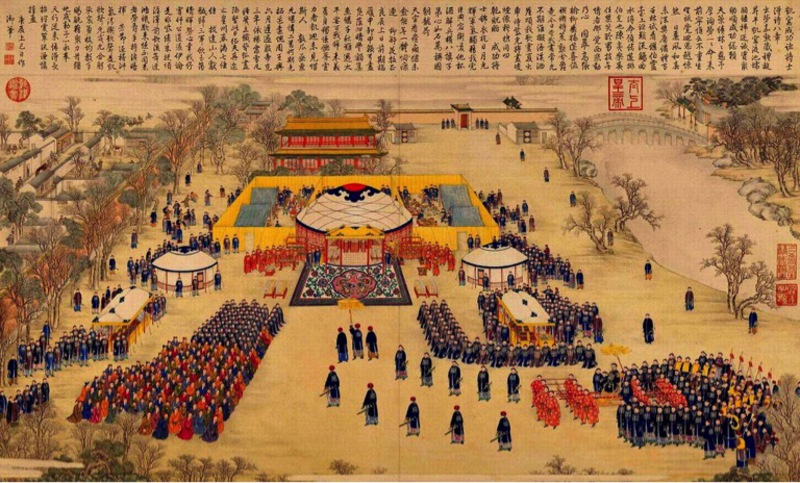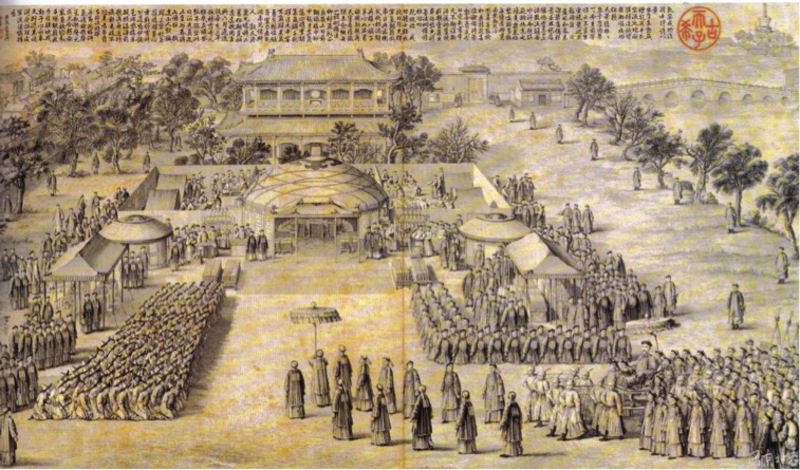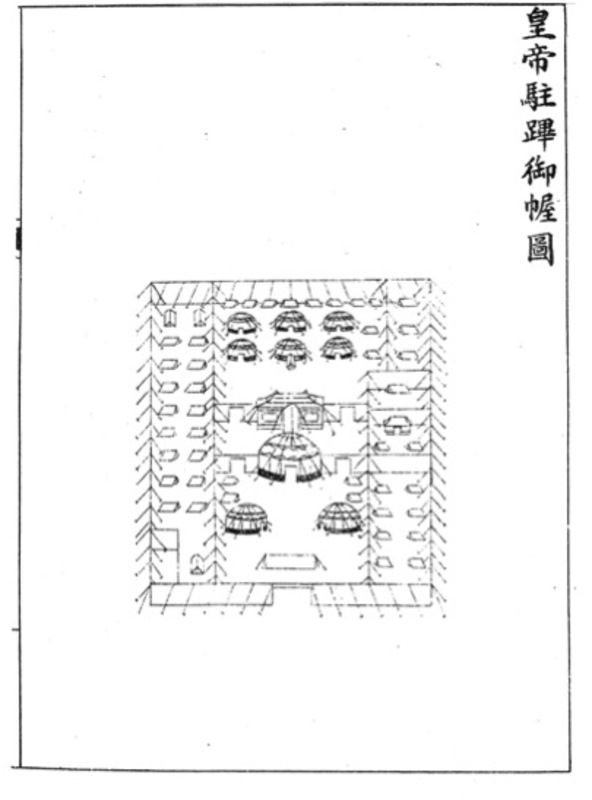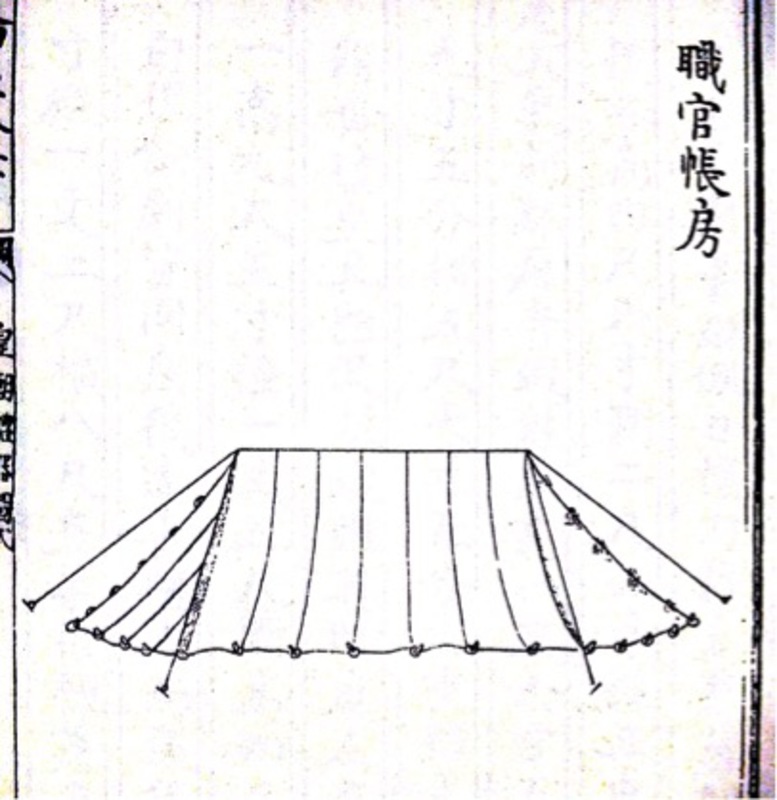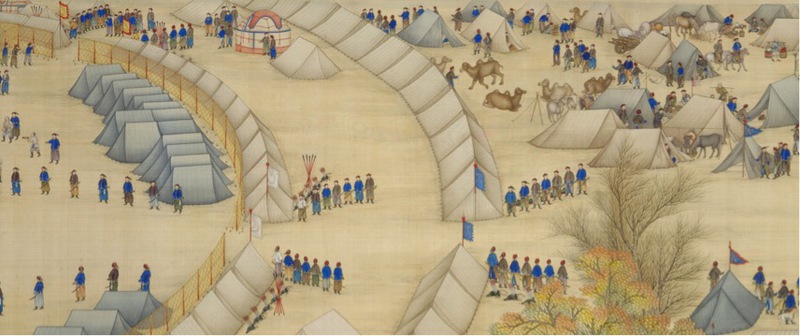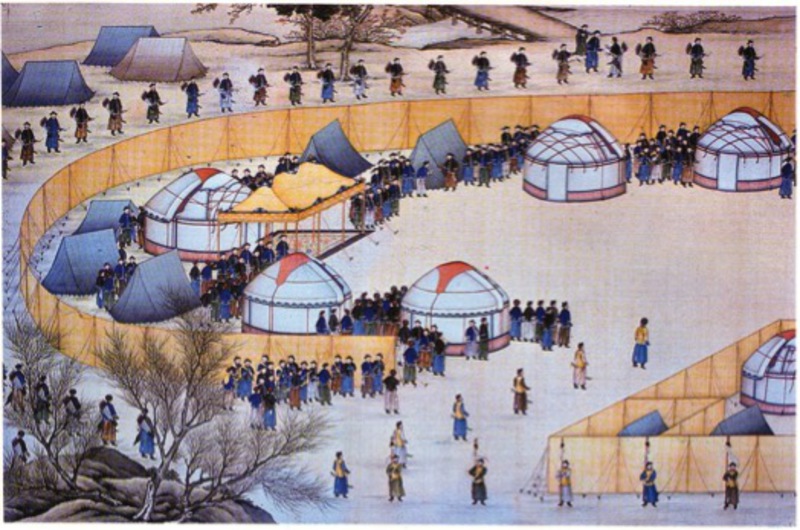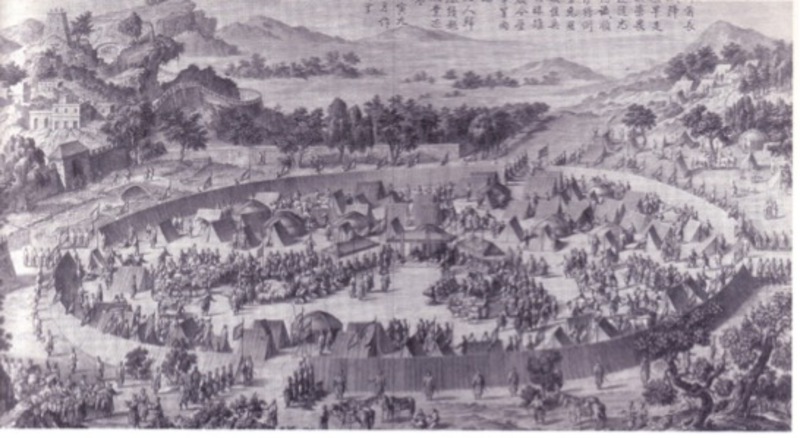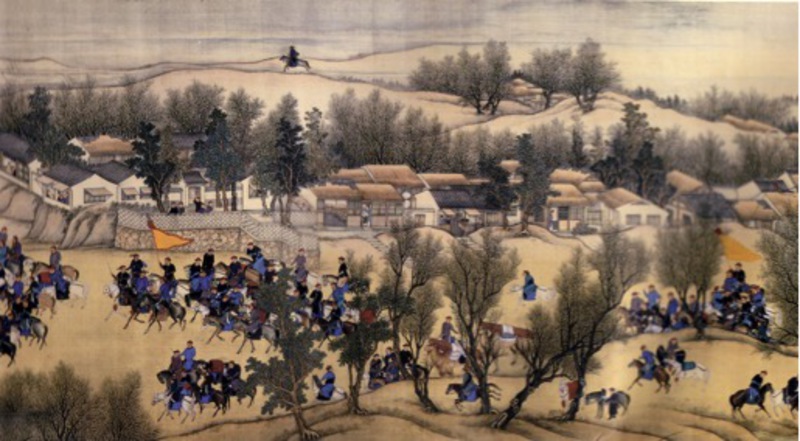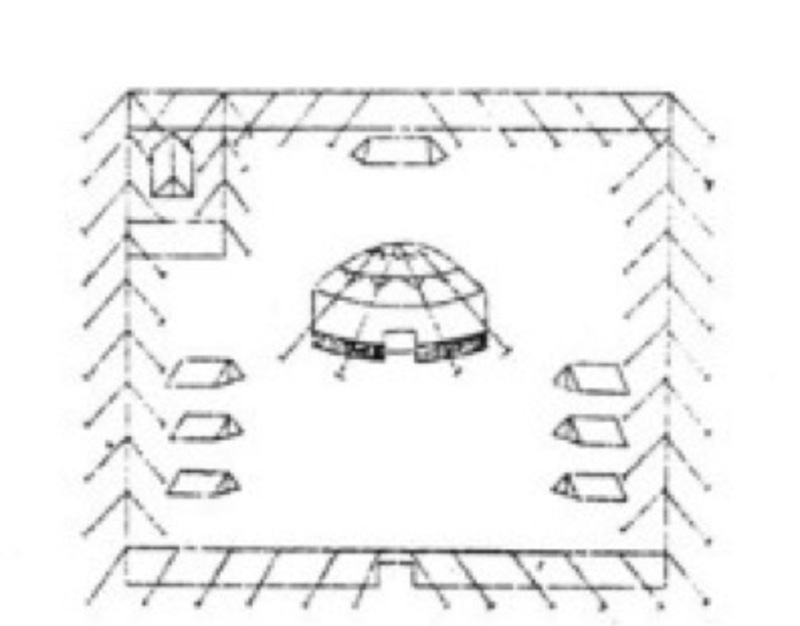A picture’s worth a thousand words. The camera does not lie. Seeing is believing. Such are the deeply ingrained platitudes of our own historically situated ways of seeing, shaped by an age of mechanical reproduction and mass mediated visual culture. But what are we, as critically minded students of history, to make of the visual evidence we encounter in the archives as well as our everyday lives? If historical imagination is also a visual exercise, how are we to envision the past(s) that we study and attempt to know? In what follows, I consider such questions by focusing on the well-known southern tours of the Qianlong emperor (1711-1799, r. 1736-1795), the fourth Manchu emperor to rule over China proper.
|
Figure 1: The route of the Emperor Qianlong’s southern tours. Unless noted, the source for all graphics. |
Each of Qianlong’s six southern tours, which took place between 1751 and 1784,1 were extended affairs, during which the emperor and his rather sizeable entourage spent anywhere from three to five months traveling through one of the empire’s most prosperous and critical regions-the Lower Yangtze delta (Jiangnan) (Figure 1). “Jiangnan” literally means “south of the (Yangtze) River,” but actually refers to a more broadly defined geo-cultural region straddling the boundary of two key provinces: Jiangsu and Zhejiang. During the seventeenth and eighteenth centuries, these two provinces were vital to the Qing empire in a number of ways.2 Politically, Han Chinese literati from Jiangsu and Zhejiang comprised the majority of officials who staffed the lower echelons of the civil administration. Economically, these two provinces generated the bulk of the empire’s commercial and agricultural wealth, supplying it with surplus (tribute) grain and the lion’s share of tax revenues, not to mention other critical staples and luxury items such as salt, silk, and porcelain. Culturally, Jiangnan was not only the undisputed center of Han literati scholarship and refinement, but also, from the Qing conquest in the mid-seventeenth century onward, a bastion of Ming loyalism and anti-Manchu sentiment.
Qianlong engaged in a wide range of other activities on his visits to the Lower Yangtze region. He inspected hydraulic infrastructure, presented obeisance to local deities, evaluated local officials, held audiences with local notables, showered individual officials and subjects with imperial favor and recognition, recruited scholarly and literary talents, conducted military reviews, visited scenic and historic sites, and even received tribal envoys from Inner Asia.
But what did a southern tour actually look like? Such deceptively simple questions provide the starting points of most historical inquiry; they are born of a certain degree of ignorance, which is a necessary precondition of curiosity. The answers at which we arrive depend upon our capacity to both critically evaluate and creatively interpret the range of perspectives offered by sources at hand. In the pages that follow, we will consider a variety of sources including court paintings, imperial poetry, literati accounts, administrative regulations, and archival documents. By reading this wide array of sources in conjunction with and against each other, we may conclude, somewhat counter-intuitively and paradoxically, that the court paintings of the Qianlong emperor’s southern tours, while helpful in many respects, do not necessarily provide us with a complete picture (pardon the pun) of those spectacular events.
The Mobile Court as Ethnic Detachment
One way of envisioning Qianlong’s southern tours is to ask ourselves: What was the visual impact and symbolic meaning of the mobile court in the Lower Yangtze delta?
When thinking about and imagining Qianlong’s trips to the South, some of the most persistent images that come to mind are those of the Qianlong emperor as a consummate literati tourist, visiting the scenic sites of Jiangnan and littering the landscape with specimens of his poetry. This makes perfect sense. After all, Qianlong was in Jiangnan-a “land of rice and fish” and a bastion of Han literati refinement and poetic sensibility. Moreover, Qianlong’s poetic output during his southern tours was, indeed, prodigious.
We will return to Qianlong’s poetry in a later section. But let us begin by noting that rarely does the mention of a southern tour lead us to imagine the more prosaic problems involved in transforming the Qing court into a mobile entity. River crossings like that seen in Figure 2 are usually not the first things to come to mind when we think of the southern tours.
|
Figure 2: Scenes like this reveal some of the complicated, but often overlooked, logistics involved in transforming the Qing court into a mobile entity. |
|
Figure 3: A portrait of Joohoi in full battle armor. Joohoi was one of the commanders of the Imperial Escorts for Qianlong’s earliest southern tours as well as a highly decorated and experienced field commander and expert in military supply who saw frontline action in Qianlong’s famed “Western Campaigns” (1755-1759). |
The logistics of the imperial procession and imperial camps seem somewhat secondary, so much backdrop to the “real” business of the southern tours. We would do well to remember, however, that the hallmark, and indeed the central spectacle, of any southern tour was the physical presence of a mobile court in Jiangnan, both on horseback and in camp. More to the point, during the eighteenth century, the moving court, in and of itself, was an emblem of frontier-style mobility and martial prowess that alluded to the Qing dynasty’s non-Chinese provenance. The logistical management of the two most basic forms of the mobile court-namely, imperial bivouacs and the imperial procession-deserve further consideration precisely because they were ethnically imbued projections of imperial authority in Jiangnan.
The Qianlong court approached the logistical management of the imperial procession and encampments as a military endeavor to be dominated by members of the metropolitan conquest elite, who would be in charge of providing for the emperor’s most basic needs and security while he was away from Beijing. Chief among these were the six Grand Ministerial and Princely Superintendents of the Imperial Encampment (zongli xingying wang dachen), an ad hoc body, whose members were selected from the ranks of the Imperial Clan, the Mongolian nobility, and senior Manchu officials. Han Chinese officials were strictly excluded. Even more crucial to the on-the-ground planning and logistics of the southern tours were the Imperial Escorts (xiangdao; Manchu: yarhūdai be kadalara amban). This elite detachment of bannermen performed the actual legwork of scouting and reconnaissance both before and during all imperial tours of inspection, including the southern tours.
Two high-ranking Manchu bannermen named Joohoi (Zhao-hui; 1708-1764) and Nusan (Nu-san; d. 1778) served as commanders of the Imperial Escorts for Qianlong’s earliest southern tours in the 1750s and 1760s.3 Both hailed from the Manchu Plain Yellow banner; both were highly decorated and experienced field commanders as well as experts in military supply; and both saw frontline action in Qianlong’s famed “Western Campaigns” (1755-1759).4 Figure 3 is a portrait of Joohoi in full battle armor, painted in commemoration of his military service during the conquest of the Ili River Valley (Dzungaria) and the oases towns of the Tarim Basin (Altishahr)-both of which have been known since 1760 as Xinjiang or the “New Dominions.” The Chinese inscription reads: “Great Achievement in Pacifying the Frontier” (suijiang maoji). This was one in a series of one hundred portraits of military heroes displayed in Beijing’s Hall of Purple Brilliance (Ziguang ge)-a ceremonial pavilion which Qianlong ordered rebuilt in 1761 for the purpose of feting Inner Asian tributaries, who sometimes also accompanied Qianlong during his visits to the south (Figures 4-5).5 Tribal prelates and potentates would have had occasion to see portraits such as this while in the capital, and the military background of men such as Joohoi and Nusan was unlikely to have been missed.
Besides providing scouting and reconnaissance services during the southern tours, the Imperial Escorts under the command of bannermen such as Joohoi also played a pivotal role in the annual imperial hunts at the Mulan hunting reserve (Mulan weichang; Manchu: Muran-i aba), located north of the Great Wall. Here the Imperial Escorts were responsible for scouting specific hunting areas and then setting up the emperor’s main base camp at an appropriate site within the larger Mulan complex.6 The continuity of personnel in charge of logistics for both the Mulan hunts and imperial tours meant that when the Qianlong court visited the Lower Yangtze region it resembled an ethnic detachment of Inner Asian elites engaging in a form of military exercise.
“Felt Quarters” and “Boats of the Steppe”: Encampments as Emblems of Ethnic Authority
The imperial encampment was perhaps the most conspicuous projection of the Qing court’s claim to an Inner Asian heritage of martial mobility and prowess. Figure 6 is a schematic overview of an overnight or main imperial encampment (daying). A centrally located rectangular wall called the “yellow perimeter” (huangcheng) defined the core of the camp, the emperor’s personal quarters (Figure 7). One hundred seventy-five simple pup-tents (or “officials’ tents” zhiguan zhangfang; Figure 8) arrayed in a circle constituted an “inner perimeter” (neicheng). A second larger ring of 254 officials’ tents together with this first ring formed a security cordon. Detachments of imperial bodyguards (such as those in Figure 9) stood as sentries at the various camp entrances. As seen in Figure 7, the imperial quarters where the emperor actually spent the night consisted mostly of circular tents, commonly known as “yurts” (qionglu or Menggu bao; Manchu: Monggoi boo; Mongolian: ger).
|
Figure 4: Banquet held in honor of military officers at the Hall of Purple Brilliance (Ziguang Ge) in celebration of the Qing conquest of Dzungharia and Altishar (Scene 16 of the Pingding Zhunbu Huibu Desheng Tu by Ding Guangpeng). Source |
|
Figure 5: A rendering of the same scene in Figure 4 by the Italian Jesuit, Giuseppe Castiglione (aka Lang Shining). Source |
|
Figure 6: Schematic of the Imperial Encampment |
Figure 7: A “yellow perimeter” (huang-cheng) defined the core of the imperial encampment, which contained the emperor’s personal quarters, including Mongolian ger (a.k.a. “yurts”). |
Figure 8: A simple pup-tent (or “official’s tent” zhiguan zhangfang), 254 of which were arrayed in a circle to form the imperial encampment’s “inner perimeter” (neicheng). |
Mongolian ger (yurts) of various sizes figured prominently in court paintings such as Giuseppe Castiglione’s “Gathering for a Meal during the Hunt” (Figure 10) and the “Imperial Banquet in the Garden of Ten-Thousand Trees” (Figure 11), the latter of which was imperially commissioned in 1754 to commemorate the submission of the “Three Cerings” (Cering, Cering Ubaši, and Cering Mongke) and featured a “Great Yurt” (Yuwo da Menggu bao). Finally, Figure 12 is a less schematic picture of an encampment in which we see some ger (yurts) and the bunting that was used for the yellow perimeter.
|
Figure 9: Detachments of imperial bodyguards such as these stood as sentries at the various camp entrances. |
|
Figure 10: “Gathering for a Meal during the Hunt” by Giuseppe Castiglione (aka Lang Shining). |
Figures 9 and 12 which depict bodyguards and ger (yurts) are actually details from a set of official court paintings, four large scrolls collectively known as “Illustrations of the Mulan Hunt” (Mulantu), produced by court painters sometime during the 1750s under the direction of the Italian Jesuit, Giuseppe Castiglione (Lang Shining, 1688-1766).7
Encampments such as these were a quintessential symbol of martial prowess and the projection of Qing power into Inner Asia. Figures 13 and 14 show two camps in which Qing commanders received the surrender of the Beg of Ush in 1758 and the Khan of Badakhshan in 1759, respectively.
These two images of encampments are from a larger set of sixteen court paintings known as “Illustrations of the Pacification of Ili and the Muslim Tribes” (Pingding Yili Huibu zhantu) completed in 1766, again under the direction of Jesuit missionaries at the Qianlong court. For sake of clarity and convenience, I will refer to these pacification paintings as Desheng tu or “Illustrations of Military Victories,” a shorter title which was used from the 1770s onwards. These sixteen “Illustrations of Military Victories” were painted on the walls of the aforementioned Ziguang ge-the ceremonial hall in Beijing where portraits of military heroes were also displayed (see Figures 4 and 5).8 As the various images under discussion demonstrate, large, circular encampments along with Mongolian ger (yurts) were part and parcel of an Inner Asian political culture that centered upon hunting as well as the conduct of actual warfare and diplomacy on the Inner Asian steppe.
But were tent encampments such as those featured in Figures 6-14 also used in the Lower Yangtze delta during the Qianlong emperor’s southern tours? In addressing this question, our first inclination might be to turn to yet another group of court paintings known as “Illustrations of Southern Tours” (Nanxun tu). Two sets of southern tour paintings, each consisting of twelve large scrolls, were produced by the Qing court. The first set commemorated the earliest southern tours of the Kangxi emperor (1654-1722, r. 1661-1722), Qianlong’s grandfather, and was completed in 1691 under the direction of Wang Hui (1632-1717), a Han Chinese literatus-painter and native of Suzhou prefecture. Never to be outdone, the Qianlong emperor commissioned a second set of southern tour scrolls to commemorate his own trips to the south. This second set of southern tour scrolls was completed in the 1750s and 1760s under the direction of one Xu Yang, another Han Chinese court painter who hailed from the Suzhou area.
|
Figure 11: “Imperial Banquet in the Garden of Ten-Thousand Trees” |
|
Figure 12: The “yellow perimeter” and ger at the Mulan hunting grounds. |
|
Figure 13: Qing commanders received the surrender of the Beg of Ush in 1758 in a military encampment that clearly resembled the encampments used during imperial hunts and during other imperial tours of inspection, such as the Qianlong emperor’s southern tours to the Lower Yangtze delta |
|
Figure 14: Surrender of the Khan of Badakhshan, 1759 |
A close examination of both published images and existing scholarship suggests that depictions of imperial camps are conspicuously absent in both the Kangxi- and Qianlong-era southern tour scrolls.9 The closest that one comes to even seeing a single ger (yurt), let alone an entire imperial encampment, in the southern tour paintings is at the bottom of Figure 15, a detail from the first scroll of the Kangxi-era southern tour paintings, which shows two camels with collapsed ger-frames packed on their backs.
|
Figure 15: Detail from the first scroll of the Kangxi era southern tour paintings, which shows two camels with collapsed yurts packed on their backs. |
|
Figure 16: Line drawing of a day camp set up at intermediate rest stops (jianying, dunying, or wu-dun; Manchu: uden-i ba) |
A naïve or straightforward reading of the southern tour paintings as mirror-like reflections of historical reality might lead us to conclude that imperial encampments like those portrayed in Figures 6-14 were in fact not used during the southern tours. However, both archival and published sources provide incontrovertible evidence that two sets of equipment for these large sorts of circular camps were in fact used in a “leap-frogging” manner as the Qianlong emperor traveled through the South.10
|
Figure 17: Emperor Qianlong on horseback and dressed in ceremonial armor on the occasion of a Grand Military Review (by Giuseppe Castiglione, c. 1758); Source
|
Of course, encampments were not the only form of lodging available to the emperor during a southern tour; he might also stay in more permanent structures designated as imperial lodges or travel-palaces (xinggong; Manchu: tatara gurung). Indeed, Qianlong increasingly resided in imperial lodges as more and more were constructed during the late-1750s and 1760s. But this did not obviate the need for tents and encampments during his visits to Jiangnan. After all, even the most elaborate imperial lodges were not large enough to accommodate Qianlong’s entire retinue of some 2,000-3,000 people. For example, archival documents reveal that during Qianlong’s third and fourth southern tours of 1762 and 1765, the Grand Council, other metropolitan ministers, and high provincial officials all frequently camped in tents. Indeed, a total of 1,100 extra tents were needed at five overnight stops even though imperial lodges were already built there.
In addition, during each day’s travels the emperor would take meals and receive local officials at one or two intermediate rest stops (jianying, dunying, or wu-dun; Manchu: uden-i ba) where bannermen would set up secondary day camps.11 As Figure 16 illustrates, the main structure of these intermediate camps was a Mongolian ger (yurt).12
Here we may appreciate how the intermediate camp in Figure 16 resembles the scene portrayed in Giuseppe Castiglione’s “Gathering for a Meal during the Hunt” (Figure 10). Also worth noting is Qianlong’s order in 1755 that of the four colonels and sixty guardsmen in charge of logistics and security for intermediate encampments, one colonel and twenty guardsmen were to be drawn specifically from Mongol units. So, even though the Qianlong reign witnessed an increase in the number of imperial lodges along the route of the southern tours, camps and Mongolian ger (yurts) did not disappear. On the contrary, the Qianlong emperor became even more insistent that they continue to be used. In short, imperial encampments and Mongolian ger (yurts) were symbolically significant, even in the most densely populated and Chinese-dominated urban areas of the Lower Yangtze delta.
Here the irony and the lesson is that when we think about the visual impact of the southern tours, we actually cannot simply rely upon the court paintings of the southern tours. As we have seen, southern tour scrolls alone do not necessarily reveal whether encampments were used on Qianlong’s southern tours. Instead, the historian must rely upon written sources (administrative regulations, archival documents, imperial poetry, etc.) for that information.
So what use are Qing court paintings and other types of visual sources to us as students of history? What can or what do they reveal about the past? Clearly none of the court paintings necessarily represent reality in any direct (or positivistic) manner. On the contrary, they are themselves ideologically imbued documents that serve to maintain strict and stereotypical boundaries between northern and southern landscapes, between civil and military spheres, and between Chinese and Inner Asian cultural and political sensibilities. Curiously enough, Qianlong put Jesuits-namely, Giuseppe Castiglione, Ignatius Sichelbart (Ai Qimeng, 1708-1780), Denis Attiret (Wang Zhicheng, 1702-1768), and Jean-Damascène Salusti (An Deyi, d. 1781)-in charge of the “Illustrations of the Mulan Hunt” as well as the “Illustrations of Military Victories.” Meanwhile, he left Xu Yang, a court (artisan) painter from Suzhou, to direct the “Illustrations of the Southern Tours.” Might this rather stark division of labor between Jesuit and court (artisan) painters on the one hand, and Han Chinese literati artists on the other stem from Qianlong’s presumption that the latter group (Chinese literati) harbored some sort of cultural aversion (or at the very least a sensitivity) toward the painterly depiction of triumphantly martial motifs? This question is beyond the scope of the present study and is perhaps best left for more qualified colleagues to take up in future research.13
|
Figure 18: Qianlong entering Suzhou via Xumen |
|
Figure 19: Qianlong entering the summer palace complex at Chengde |
|
Figure 20: Qianlong Engaging in the Battue Hunt, also featuring the emperor on horseback surrounded by his most loyal and stalwart Manchu and Mongolian troops |
In any case, the three sets of court paintings allow us to unravel an important skein of cultural reference, from which we might reconstruct important meanings associated with the use of encampments and ger (yurts) during the southern tours, a fact corroborated by written sources. Considered together and read against each other, the “Illustrations of Southern Tours,” “Illustrations of the Mulan Hunt,” and “Illustrations of Military Victories” form a neat visual taxonomy (or a symbolic index) in which tent encampments and Mongolian ger (yurts) are exclusively associated with Inner Asian landscapes and a highly mobile and militarized political culture. Meanwhile, the southern tour paintings are intended as a tribute to southern landscapes and political sensibilities. It is against this highly idealized and stereotypical southern landscape that painterly portrayals of encampments and Mongolian ger (yurts) would have been wholly out of place.
But if we read the southern tour paintings as a tribute to more delicate southern Chinese sensibilities, this does not necessarily mean that the southern tours themselves were also mere exercises in Han cultural appeasement. The southern tour paintings were viewed by a very limited audience with ready access to the inner palace complex in Beijing, where experts believe they were kept.14 However, the actual use of imperial encampments and Mongolian ger (yurts) during the southern tours actually played out on the ground in the Lower Yangtze delta to a much broader audience of spectators.
In the eyes of the emperor and the broader conquest elite, the use of imperial encampments during Qianlong’s southern tours alluded to more nomadic and tribal modes of governance and political organization in which mobility was itself a form of security and a sign of martial prowess. According to a well-known Qing noble and historian of the Qianlong era, Aisin Gioro Jooliyan (Zhao-lian, 1780-1833),15 the use of imperial encampments during imperial hunts as well as tours of inspection was undertaken not only “in reverence of simplicity and frugality” but also “for the purpose of remembering the origins” of the empire.16 Qianlong himself equated the use of encampments during his first southern tour with free-ranging mobility on the open steppe. In early May 1751, he composed a poem entitled “Felt Quarters” (zhanshi), which is worth quoting in full:
Lodging overnight on the overland route, We use “felt quarters” as usual.
The shadows of strong steeds fall upon empty window openings.
Moving about at will through both north and south,
In warm and cold weather, according to the seasons.
Immediately upon waking, We give orders to break camp,
And make proper arrangements to dispatch the scouts.
Whether on the move or in camp, the tents remain unaltered [constant].
Thus are they nicknamed “boats of the steppe” [pingyuan zhi zhou].17
Han Chinese elites hailing from Jiangnan also recognized the martial connotations that inhered in Qianlong’s use of tent encampments. For example, Shen Deqian (1673-1769), a prominent poet and literary critic from Suzhou, described his imperial audiences with the Qianlong emperor in 1751 and 1757 as having occurred within the “military encampment” (wuzhang) pitched at the confluence of the Yellow River and the Grand Canal in Qingjiang.18
Many other Han elites who witnessed the use of imperial encampments in the south may have either consciously or unconsciously avoided such references precisely because encampments symbolized the court’s non-Chinese origins and ongoing preoccupations with Inner Asian diplomacy and military conquest. As noted earlier, the military encampments in the “Illustrations of Military Victories” were prominently painted on the walls of the ceremonial hall for military heroes-the Ziguang ge-in Beijing. This means that such images were seen by a public audience comprised of not only Inner Asian tributaries and courtiers, but also metropolitan officials, many of whom hailed from Jiangnan. Moreover, such scenes of Inner Asian conquest and diplomacy also circulated beyond official circles in the capital. In fact, prints of these very same conquest scenes (made from copper engravings etched in Paris19) were eventually installed at fourteen locations along the route of the southern tours in June of 1784 immediately after the completion of Qianlong’s sixth and final southern tour.20 The reception of local dignitaries and officials at encampments during the southern tours must have appeared quite similar, or at least analogous, to scenes from the “Illustrations of Military Victories” in which Inner Asian tribal leaders submitted to the Qing court’s authority (Figures 13 and 12).
The Spectacle of a “Ruler on Horseback”: the Imperial Procession
In his well-known Record of Pleasure-Boat Yangzhou (Yangzhou huafang lu, c. 1795), Li Dou, an eighteenth century denizen and local historian of Yangzhou, describes camps set up at docks approximately one mile (2-3 li) outside of city walls along the Grand Canal.21 The main structure at each of these dock encampments was a medium-sized tent with a Mongolian-style domed roof. We may fairly assume that this description refers to the intermediate day camps discussed above. Archival documents also indicate that boats carrying imperial bodyguards, Tibetan lamas, high officials from the Board of War, and twenty-four of the emperor’s steeds from the Palace Stud were the first to dock outside any urban center along the Grand Canal.22 We also know that the Superintendency of the Imperial Encampment was in charge of setting up and securing these dock camps as well as for preparing the necessary number of horses for entering cities such as Yangzhou, Suzhou, and Hangzhou.23 Given the weight of this evidence, we may reasonably conclude that the dock encampments described by Li Dou were part and parcel of the emperor’s triumphal entries on horseback and served as staging areas for a series of ritually militarized parades through Lower Yangtze cities.24 This brings us to the visual impact of the imperial procession which centered upon the conspicuous display of a ruler on horseback.
The first two standard dynastic histories, Sima Qian’s Records of the Grand Historian (Shiji) and Ban Gu’s History of the Former (Western) Han Dynasty (Hanshu), both denigrated the act of “ruling from horseback” as an illegitimate mode of governance, based solely upon the use of military force. The locus classicus for this pejorative understanding of the trope “ruling from horseback” was the biography of Lu Jia, (re)written sometime between 200-400 CE.25 Lu Jia, a native of Chu renowned for his eloquence, served the Han dynasty founder, Liu Bang (a.k.a. Han Gaozu, r. 206-195 BCE), during the overthrow of the Qin dynasty. According to his biography in both the Shiji and Hanshu, Lu Jia incessantly urged the Han founder to heed the political teachings found in the Book of Poetry and the Book of Documents. Liu Bang, for his part, grew impatient and lambasted Lu, saying, “Indeed, We have obtained [the realm] on horseback. So how can We follow the Book of Poetry and the Book of Documents?!” Lu Jia responded with his now famous adage, “Do you mean that if you take the realm on horseback you can rule it on horseback? (Ju mashang de zhi, ning keyi mashang zhizhi hu; 居馬上得之,寧可以馬上治之乎 )”26 In the final section of this essay, we will explore how, by reviving the practice of imperial touring, the Qianlong court attempted to transform the spectacle of “ruling from horseback” from a stigmatized sign of illegitimate military rule into a specific badge of ethno-dynastic (Manchu) discipline and diligence as well as benevolent civilian rule.
Recent scholarship has demonstrated that horseback riding became a marker of Manchu ethnic identity in the early- to mid-Qianlong period. The Qianlong emperor seized upon horseback riding as part of an essentialized “Manchu Way” that was supposed to simultaneously indicate and inculcate traits of martial prowess and vigor (Figure 17).27
Throughout the 1750s, the emperor voiced his concerns over the growing tendency among high-ranking Manchu officials to ride in sedan chairs. Qianlong saw this trend as a sign of laziness and dissipation among the conquest elite and responded by trying to encourage horseback riding in a number of ways. First, he issued a number of proclamations that explicitly prohibited Manchu officials from riding in sedan chairs. The corollary to this prohibition was a mandate that all high-ranking Manchu officials, regardless of whether they were serving in civil or military posts, were to ride on horseback instead.
Second and more germane to present discussion, the Qianlong emperor attempted to set a more positive example by personally embarking upon numerous imperial tours of inspection starting in the late-1740s. These included his southern tours. While in Suzhou on his second southern tour of 1757, Qianlong proclaimed in an edict:
Generals and provincial commanders are responsible for commanding officers and soldiers. If they enjoy their high position by living in ease and seeking comfort for themselves [that is, by riding in sedan chairs and carriages] then how will they be capable of leading the troops and instilling bravery by personal example? . . . Commanders and vice commanders of the metropolitan banner forces are all to ride on horseback, and Manchu vice directors [of the six boards] are forbidden to ride in sedan chairs. . . .
Qianlong concluded his tirade by emphasizing, “In the areas through which We tour, We continue to ride on horseback each day.”28
As this last statement clearly indicates, imperial tours of inspection were closely associated with horseback riding, which Qianlong, in turn, identified as an emblem of martial vigor and Manchu leadership. Imperial tours, then, were for Qianlong a means through which Manchu dominance might be secured, maintained, and displayed.29 In other words, imperial tours, including the southern tours, were occasions for the performance, preservation, and promotion of ethno-dynastic identity and virtue.
Not surprisingly, the spectacle of Qianlong’s ritual entries on horseback into urban centers appears in both the southern tour and the Mulan paintings-two genres of painting which are otherwise diametrically opposite in terms of their cultural references. In Figure 18 we see an image of Qianlong’s triumphal entry into Suzhou via Xumen taken from the Qianlong-era southern tour scrolls. A similar scene also appears in the Mulan scrolls (Figure 19) where we see Qianlong entering the summer palace complex at Chengde, again on horseback and surrounded by his bodyguard. We might also compare these images to a third painting (Figure 20) entitled “Qianlong Engaging in the Battue Hunt” (Qianlong congbo xingwei tuzhu).
Qianlong’s steeds in all three of these scenes appear to be tribute horses presented by Inner Asian tribes such as the Khalkas (in 1743) and Eastern Kazakhs (in 1757).30 The three scenes are set in very different locales: the first (Figure 18) being Suzhou, a quintessential literati city in the prosperous and Chinese-dominated south; the second (Figure 19) being the summer palace complex at Chengde, north of the Great Wall; and the third (Figure 20) being a battue site in the Mulan hunting complex itself, a bit further north of Chengde. Some minor differences in details notwithstanding,31 Qianlong’s bodyguards in all three paintings are dressed identically, as is the emperor himself-in plain-colored riding jackets (magua) and frocks. More importantly, all three paintings reinforce Qianlong’s image as an Inner Asian ruler on horseback surrounded by his most loyal Manchu and Mongolian troops-all of whom are, not surprisingly, on horseback as well.
As should be obvious by now, themes of martial prowess and ethnic difference also clearly mark the historical record of the southern tours but have rarely been noticed or commented upon by historians. In the final section of this essay we will explore how the Qianlong emperor also orchestrated spectacles of ruling from horseback in order to transvalue martial prowess and ethnic dominance into founts of benevolent civil rule as well.
Extending Ethnic Prerogatives by “Observing the People” while “Ruling from Horseback”
The image of a ruler on horseback was not restricted to court paintings, but also permeated Qianlong’s poetry. As mentioned above, Qianlong produced many poems while on tour, and they were meant for broad public consumption. In fact, the first chapters in gazetteers for prefectures-such as Yangzhou (1810), Suzhou (1824, 1877), and Hangzhou (1784)-consist entirely of reprinted imperial poems written during the southern tours.32 Qianlong ordered the compilation of his poetry while he moved through these areas, and he clearly wanted them to serve as a narrative record for posterity.33
As one might expect, the many poems that the Qianlong emperor composed (or had someone else compose) during his southern tours are replete with refutations against possible claims that he might be visiting the Lower Yangtze on a mere pleasure junket. Upon arriving in Suzhou in 1751, Qianlong wrote, “The imperial procession alights in old Suzhou. / This is for the purpose of taking measure of popular sentiments. How could it be for Our Own pleasure?”34 While riding his horse through Changzhou during his second southern tour, Qianlong wrote, “The purpose of coming to the South is to observe the people. / How could it be for the purpose of enjoying the wispy scenery?”35
Verses such as these can be found throughout the voluminous corpus of Qianlong’s southern tour poems. Clearly, he strove to present himself as an emperor hard at work, not hard at play. In doing so, he seized upon a canonical discourse of “observing the people” (guanmin). While in Suzhou in 1757, Qianlong declared that “in visiting the south, two matters are of utmost importance: inspecting the Yellow River and observing the people.”36
Qianlong was fully cognizant that “observing the people” was not only about seeing, but also about being seen. In early-1750, a full year before his inaugural southern tour began, Qianlong issued an edict “regarding preparation of the royal road” in which he insisted upon high visibility: “Although the view in some areas is interrupted or entirely blocked by straw and cloth bunting, the view from wide open spaces must be kept completely unobstructed.”37 On the day of his actual departure from Beijing, the emperor eagerly anticipated the “throngs of people” who had already “crowded city boulevards in order to gaze upon the imperial procession” and was pleased to hear that “the gentry, local elders, and commoners all hoped to draw close to the radiant aura of the imperial presence.” There was, however, one problem. Qianlong “truly feared that some local authorities were worried about overcrowding and might thus cordon off their jurisdictions ahead of time.” Nevertheless, he was adamant about keeping the niggling of petty bureaucrats from putting a damper on the show. “If the roads are wide and spacious and securing the route is not expected to cause undue congestion,” Qianlong wrote in a special edict, “then local officials are not to issue blanket prohibitions aimed at obstructing the sincere desire of ordinary subjects to draw near and gaze upon the emperor [zhanjiu].”38 Having reached Suzhou six weeks later, Qianlong proudly proclaimed: “Since entering the province [of Jiangsu] a short time ago, both elderly and young have eagerly come forth, drawing near and gazing upon the imperial procession. Their genuine admiration and respect are quite pleasing.”39 Li Dou echoed the emperor’s account: “Colorfully draped pavilions and waterborne stages were set up along the imperial route. All were a manifestation of deep sincerity. Every place through which [the imperial procession] passed was like this.”40 As Qianlong would have it, the act of gazing was mutual and suffused with specific meanings; it “both satisfied the [general populace’s] sincere desire for an imperial visit and provided occasion for Us to observe the flourishing of local customs and popular sentiments.”41 In short, the southern tours were for Qianlong a means of conjuring popular acclamation.
These well-rehearsed rituals of manufacturing consent were ideologically unassailable because the phrase “observing the people” alluded to canonical precepts of benevolent civil governance found in the Book of Changes (Yijing or Zhouyi),42 the Book of Poetry (Shijing or Mao Shi),43 and the Liji44 that were firmly supported by authoritative Han, Tang, and Song-era commentaries by well-known Confucian scholars: Zheng Xuan (127-200), Kong Yingda (574-648), and Zhu Xi (1130-1200). The Qianlong emperor’s stated desire to “allow common folk to draw nearer” so that they might “more easily gaze upon [Us]” dovetailed nicely with standard interpretations of the hexagram for “contemplation” (guan) in the Book of Changes. Qianlong elucidated his own interpretation of “observing the people” in a poem he composed on April 25, 1780, as he set out for Jiangning on the return leg of his fifth southern tour.45 The imperial interpretation derived from a canonical reading of the hexagram guan in which “a slight variation in the tonal stress gives the Chinese name for this hexagram [guan] a double meaning. It means both contemplating [that is-seeing, viewing, or observing] and being seen, in the sense of being an example. . . . The hexagram shows a ruler who contemplates the law of heaven above him and the ways of the people below, and who, by means of good government, sets a lofty example to the masses.”46
It may be tempting to read imperial invocations of “observing the people” as a cultural concession whereby the Qianlong emperor presented himself as a “Confucian” defender of venerable political principles. After all, classically educated scholar-officials were surely familiar with the discourse of “observing the people” and probably found Qianlong’s justification of his southern tours in this canonical idiom both politically palatable and culturally reassuring, not to mention ideologically unassailable. Although this interpretation of the southern tours as a form of cultural appeasement or propitiation is not entirely inaccurate, neither does it tell the whole story. An analysis centered solely upon the Qing court’s acknowledgement of Han literati ideals may actually prevent us from fully appreciating the subtle workings of Qianlong’s ideological statements and the complexities of the broader political culture in which he operated. More specifically, a close analysis of how the Qianlong emperor deftly intertwined classically-sanctioned notions of “observing the people” with explicit references to horseback riding in his southern tour poetry provides important insight into the active process by which he continued to elaborate upon the concept of “ruling from horseback” as a legitimate and ethnically imbued mode of diligent and benevolent civil governance during his southern tours
Qianlong’s southern tour poetry is filled with descriptions of himself “driving a horse” (cema, ceji), “sitting in the saddle” (ju’an), “mounting a steed” (chengma), and “drawing in the reigns” (anpei),47 especially as he inspected the critical hydraulic infrastructure along the Yellow River48 and the Zhejiang coastal seawalls.49 Although such self-descriptions of an emperor on horseback are far too numerous to describe and analyze in individual detail here, one important point deserves our attention.
Whether traveling overland or via the Grand Canal, the Qianlong emperor insisted on riding on horseback when passing through administrative seats at the provincial, prefectural, and district levels50 as well as when he visited scenic sites on the outskirts of major urban centers such as Yangzhou, Suzhou, Hangzhou, and Jiangning.51 His reasoning was that “[traveling by] horse is more convenient than [traveling by] boat and also allows the common folk to draw nearer to [Our] radiance.”52 Indeed, it was an explicit policy that “each time [the imperial procession] arrives at a walled city, most disembark from the boats and ride horses [cema] past [the urban area]. [Our] desire is to observe the people [guanmin] and this [riding on horseback] is in accordance with the people’s wishes.”53 This strictly enforced protocol explicitly identified the practice of horseback riding as a means of realizing a classically-sanctioned tenet of “observing the people” (guanmin).
Qianlong’s insistence on horseback riding during his southern tours, then, derived from neither administrative nor logistical necessity, but rather from his ideological commitment to ethno-dynastic aggrandizement. During his travels through Jiangnan, Qianlong legitimized the ethno-dynastic spectacle of “ruling from horseback” as a means of inspecting hydraulic infrastructure and “observing the people”-that is, as a perfect vehicle for realizing diligent administration and benevolent civil rule in China proper.
Conclusion
Qianlong’s southern tours, then, were political spectacles of the first order that necessarily entailed ideologically pregnant acts of seeing and being seen. Historical inquiry may also be thought of as entailing acts of imagination and visualization based upon the historian’s critical and creative interpretation of available sources. As we have seen above, the Qianlong emperor imagined and presented himself as a ruler concerned with the tasks of benevolent civil governance. At the same time, he would forsake neither his identity as a Manchu, nor his ideological commitment to ethno-dynastic aggrandizement. He presented himself as both a “Confucian monarch” and a “Manchu ethnarch,” and he did this by transforming the ethno-dynastic spectacle of “ruling from horseback” into a means of “observing the people.” Ruling from horseback in the Lower Yangtze delta, then, became an assertion of Manchu virtues and exceptionalism in both military and civil affairs. This was a new ideological horizon that extended Manchu prerogatives into the sphere of civil administration and statecraft. Qianlong’s southern tours were not simple exercises in cultural concession in which his ethnic identity was hidden behind or subsumed under that of a literati tourist or even a “Confucian” monarch. Instead, Qianlong’s southern tours-as constituted in both official discourses and imperial paintings-should be viewed as ideological constructs, constituted through dynamics of cultural appropriation and redaction. It was through such acts of appropriation and redaction that Manchu ethno-dynastic rule was legitimated as the most appropriate means by which to realize venerable ideals of benevolent civil governance in China proper.
***
This essay is adapted from “Envisioning the Spectacles of Emperor Qianlong’s Tours of Southern China: an Exercise in Historical Imagination,” p. 25-46 inJames A. Cook, Joshua L. Goldstein, Matthew D. Johnson, and Sigrid Schmalzer, eds. Visualizing Modern China: Image, History, and Memory, 1750-Present (New York: Lexington Books, 2014). Using image-driven scholarship to further students’ understanding of critical historical issues, Visualizing Modern China offers a sophisticated yet accessible interpretation of modern Chinese history through visual sources. With rich illustrations and a companion website (Vizualizing Modern China), it is an ideal textbook for college-level courses on modern Chinese history and on modern visual culture. The introduction provides a methodological framework and historical overview, while the chronologically arranged chapters use engaging case studies to explore important themes such as Qing court spectacle, rebellion and war, urban/rural relations, art and architecture, sports, the Chinese diaspora, state politics, film propaganda and censorship, youth in the Cultural Revolution, environmentalism, and Internet culture.
Michael G. Chang is a specialist in the history of the Qing dynasty (1644-1911). He received his A.B. in sociology and East Asian Studies from Princeton University and his Ph.D. in Chinese history from the University of California, San Diego. In addition to A Court on Horseback: Imperial Touring and the Construction of Qing Rule, 1680-1785 (Harvard, 2007), his articles have appeared in Late Imperial China, Frontiers of History in China, The Qing History Journal (Qingshi yanjiu 清史研究) as well as in edited volumes, such as Cinema and Urban Culture in Shanghai, 1922-1943 (Stanford, 1999) and The Dynastic Centre and the Provinces: Agents and Interactions (Brill, 2014).
Recommended citation: Michael G Chang, “The Emperor Qianlong’s Tours of Southern China: Painting, Poetry and the Politics of Spectacle,” The Asia-Pacific Journal, Vol. 13, Issue 8, No. 2, February 23, 2015.
Notes
1 Qianlong’s southern tours occurred in the spring of 1751, 1757, 1762, 1765, 1780 and 1784.
2 For a concise overview see Susan Naquin and Evelyn S. Rawski, Chinese Society in the Eighteenth Century (New Haven: Yale University Press, 1987), 147-158.
3 Joohoi served as a Commander-general of the Imperial Escort (xiangdao tongling) on Qianlong’s first two southern tours in 1751 and 1757, while Nusan served in this capacity on all of Qianlong’s first four southern tours (1751, 1757, 1762, and 1765).
4 For a more see Zhuang Jifa [Chuang Chi-fa], Qing Gaozong shiquan wugong yanjiu (Taipei: Guoli Gugong bowuyuan, 1982) 9-107; Peter C. Perdue, China Marches West: The Qing Conquest of Central Eurasia (Cambridge, MA: Harvard University Press, 2005), 270-292; and James A. Millward, Beyond the Pass: Economy, Ethnicity, and Empire in Qing Central Asia, 1759-1864 (Stanford: Stanford University Press, 1998).
5 For more on the Ziguang ge see Qing-gui et al., comps., Guochao gongshi xubian (1806, reprint Beijing: Beijing guji chubanshe, 1994) juan 65; and Zhao Erxun et al., comps, Qingshi gao (Beijing: Zhonghua shuju, 1977), juan 12, 454.
6 Wang Shuyun, Qingdai beixun yudao he saiwai xinggong (Beijing: Zhongguo huanjing kexue chubanshe, 1989), 26-27.
7 Bi Meixue [Michèle Pirazzoli-t’Serstevens] and Hou Jinglang, Mulan tu yu Qianlong qiuji dalie zhi yanjiu (Taipei: Guoli Gugong bowuyuan, 1982), 98.
8 Arthur W. Hummel, ed., Eminent Chinese of the Ch’ing Period [hereafter abbreviated as ECCP] (Washington, D.C.: Government Printing Office, 1943-44), 74; and Qing-gui et al., Guochao gongshi xubian, juan 97, 960-966.
9 Many thanks to Cary Liu, a curator at Princeton University’s Museum of Fine Art, who has alerted me to the presence of one temporary structure depicted in one of the scrolls of the Qianlong-era Nanxun tu. Although tent structures appear in the Nanxun tu, they are not a central element of the composition, and there is no representation of anything resembling an imperial encampment.
10 Zhongguo diyi lishi dang’an guan, comp. Qianlong chao shangyu dang [hereafter abbreviated as QLCSYD] (Beijing: Dang’an chubanshe, 1991), v. 2, 886, doc. (4), QL 21/12.
11 Wang Zhenyu, Yangji zhai conglu (Hangzhou: Zhejiang guji chubanshe, 1985), 48.
12 Tuojin et al., comps., Da Qing huidian (Jiaqing chao) (Taipei: Wenhai chubanshe, 1991), juan 874, 31b-32a and 33b.
13 Here I would like to express my gratitude to Dr. Claudia Brown, Professor of Art History at Arizona State University for alerting me (via personal correspondence) to the importance of distinguishing between three groups of artists working at the Qing court: Jesuits, Han Chinese literati, and Han Chinese court painters (artisans).
14 Maxwell K. Hearn, “The ‘Kangxi Southern Inspection Tour’: A Narrative Program by Wang Hui,” (Ph.D. dissertation, Princeton University, 1990), 63-64.
15 ECCP, 78-80.
16 Zhao-lian [Aisin Gioro Jooliyan], Xiaoting zalu (Beijing: Zhonghua shuju, 1980), 372.
17 Gao Jin, comp. Nanxun shengdian [hereafter abbreviated as NXSD] (Taipei: Xinxing shuju, 1991), juan 11, 26a.
18 Shen Deqian, Shen Deqian ziding nianpu (Jiaozhong tang ed., 1764), 44b and 55b.
19 ECCP, 74. Four Jesuit priests then living in Beijing-Giuseppe Castiglione, Ignatius Sichelbart, Jean-Denis Attiret, and Jean-Damascène Salusti-were ordered to make reproductions of these scenes for engraving. The copper engravings themselves were completed in Paris in 1774. A set of prints consisted of thirty-four sheets with sixteen paintings, sixteen poems, a preface, and a postscript. One hundred sets were sent to China of which only a few are extant. A complete set is preserved in the U.S. Library of Congress.
20 Sa-zai et al., comps., Qinding nanxun shengdian [hereafter abbreviated as QDNXSD] (Taipei: Taiwan Shangwu yinshuguan, 1983), juan 81, 5b. Locations included temples and other noted sites in Yangzhou, Wuxi, Suzhou, and Hangzhou.
21 Li Dou, Yangzhou huafang lu (Beijing: Zhonghua shuju, 1960), juan 1, 2-3.
22 QLCSYD, v. 2, 889.
23 Lufu zouzhe, Junji dang (Grand Council reference collection), Zhongguo diyi lishi dang’an guan (First Historical Archives of China) [hereafter abbreviated as LFZZ (B)], microfilm roll 033, frame no. 1153, Injišan, QL 29/10/21.
24 The Qianlong emperor’s movements through the city of Yangzhou during his first southern tour of 1751 buttress the undertone of martial vigor, with the procession passing through the parade grounds of the Green Standard military garrison in the middle of Yangzhou’s new city, and the emperor encamping at to the east of the city wall. See Li, Yangzhou huafang lu, juan 9, 194.
25 A.F.P. Hulsewé, “Shih chi,” in Michael Loewe, ed., Early Chinese Texts [hereafter abbreviated as ECT] (Berkeley: Sociaety for the Study of Early China and the Institute of East Asian Studies, 1993), 405.
26 Sima Qian, Shiji (Beijing: Zhonghua shuju, 1997), juan 97, p. 2697-2706 (Zhonghua ed., p. 683.1-685.1); and Ban Gu, Hanshu (Beijing: Zhonghua shuju, 1997), juan 43, p. 2111-2116 (Zhonghua ed., p. 540.2-541.2).
27 Mark C. Elliott, The Manchu Way: The Eight Banners and Ethnic Identity (Stanford: Stanford University Press, 2001), 8 and 275-304.
28 QLCSYD, v. 3, 18, doc. 80 (edict QL22/2/28, 1757/4/16).
29 Michael G. Chang, “A Court on Horseback: Constructing Manchu Ethno-Dynastic Rule in China, 1751-1784” (Ph.D. dissertation, University of California, San Diego, 2001), 255-292.
30 For paintings of tribute horses presented by the Khalkas (1743), Kazakhs (1757), and Afghans (1762) see Cécile and Michel Beurdeley, Giuseppe Castiglione: A Jesuit Painter at the Court of the Chinese Emperors (Rutland, VT and Tokyo: Tuttle, 1971), 103-105, 120-123, 165-166 (nos. 18-23), and 167-168 (no. 27).
31 In the Mulan scrolls (Figure 19), Qianlong’s bodyguard is armed with bows and arrows. Meanwhile in the Suzhou scene (Figure 18), they are armed with swords, sheathed in what appear to be jade scabbards. In the third painting (Figure 20), we see that Qianlong carries his own bow and arrows and is no longer protected by an imperial umbrella.
32 A-ke-dang-a, Yao Wentian et al., comps., Yangzhou fuzhi (Taipei: Chengwen chubanshe, 1974), juan 1 (edicts), juan 2-4 (poems); Li Mingwan, Feng Guifen et al., comps., Suzhou fuzhi [hereafter abbreviated as SZFZ] (Taipei: Chengwen chubanshe, 1970), juan shou 1-3; Shao Jinhan, Zheng Yun et al., comps (Qianlong) Hangzhou fuzhi [hereafter abbreviated as HZFZ] (Shanghai: Shanghai guji chubanshe, 1995), juan shou 1-5.
33 Qianlong’s southern tour poems were collected in a total of three volumes: the first chronicling his travels from Beijing through Zhili and Shandong provinces; the second his southward movements in Jiangnan and Zhejiang; and the third all poems written on his northward return to the capital. (QDNXSD, juan 17, 32b-33a.)
34 NXSD, juan 8, 4b-5a.
35 NXSD, juan 16, 1b.
36 NXSD, juan 16, 26a.
37 NXSD, juan 1, 3a.
38 NXSD, juan 1, 21a. The term zhanjiu is a classical allusion to the phrase “drawing near the sun and gazing upon the clouds” (jiu ri zhan yun) which refers to a description of the sage-king Yao’s virtues found in Sima Qian’s Shiji. See William H. Nienhauser, Jr. et. al., trans., The Grand Scribe’s Records: Volume 1, The Memoirs of Pre-Han China (Bloomington: Indiana University Press, 1994), 6.
39 NXSD, juan 1, 27a.
40 Li, Yangzhou huafang lu, p. 3, no. 3.
41 NXSD, juan 1, 21a.
42 For Kong Yingda’s exegesis of the hexagram for guan as related to imperial touring (xunshou) as well as the concept of self-reflection (guanwo) and observing the people (guanmin) see Zhouyi zhengyi in Ruan Yuan, comp., Shisan jing zhushu (Shanghai: Shanghai guji chubanshe), p. 36.3.
43 For Zheng Xuan and Kong Yingda’s commentary on the connection between “observing the people” (guanmin) and “imperial touring” (xunshou) in antiquity see Mao Shi zhengyi in Ruan Yuan, Shisan jing zhushu, p. 264 and p. 588.3.
44 For Zheng Xuan’s annotation see Liji zhengyi in Ruan Yuan, Shisan jing zhushu, p. 1609.3.
45 The poem was entitled “Clear Weather” (Qing) (see QDNXSD, juan 18, 9a-b) and was followed with an extended gloss on the interrelated principles of “contemplating/observing oneself” (guanwo) and “contemplating/observing the people” (guanmin) based upon Zhu Xi’s commentary on the hexagram for “the ruler’s contemplation” in The Book of Changes: “When ruler contemplates / observes himself, his actions are not simply limited to his own personal merits and mistakes. This should also include contemplating / observing the well-being of people as a means of self-reflection.”
46 Richard Wilhelm, trans., The I Ching or Book of Changes, 3rd ed. (Princeton: Princeton University Press, 1967), 82.
47 For “anpei” see SZFZ, juan shou 2, 70b.
48 NXSD, juan 7, 10a [1751]; and juan 23, 4b-5a [1762].
49 NXSD, juan 17, 19b-20a.
50 For instance, in cities such as (from north to south): Huai’an (NXSD, juan 7, 10a [1751]; juan 15, 9a [1757]); Gaoyou (NXSD, juan 23, 12a [1762]); Yangzhou (NXSD, juan 7, 15a [1751]; QDNXSD, juan 16, 20a-b [1780]); Changzhou (NXSD, juan 8, 2a-b [1751]; juan 16, 1a [1757]; and juan 24, 1a [1762]), etc.
51 For example, Tiger Hill (Huqiu) (NXSD, juan 24, 16b-17a [1762]; and juan 32, 8b-9a [1765]); Mount Hua (Huashan) (NXSD, juan 16, 10b-11a [1757]); etc.
52 NXSD, juan 15, 17a, QL22, 1757 (Jiangnan).
53 NXSD, juan 23, 19b, QL27, 1762 (Jiangnan).



